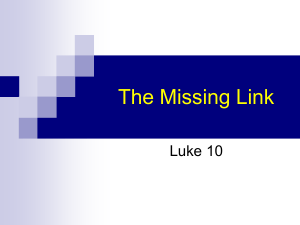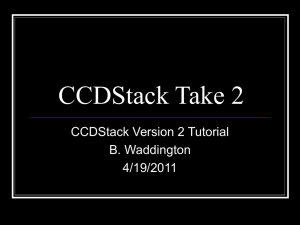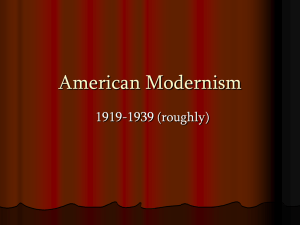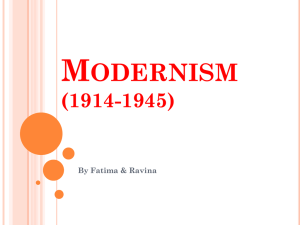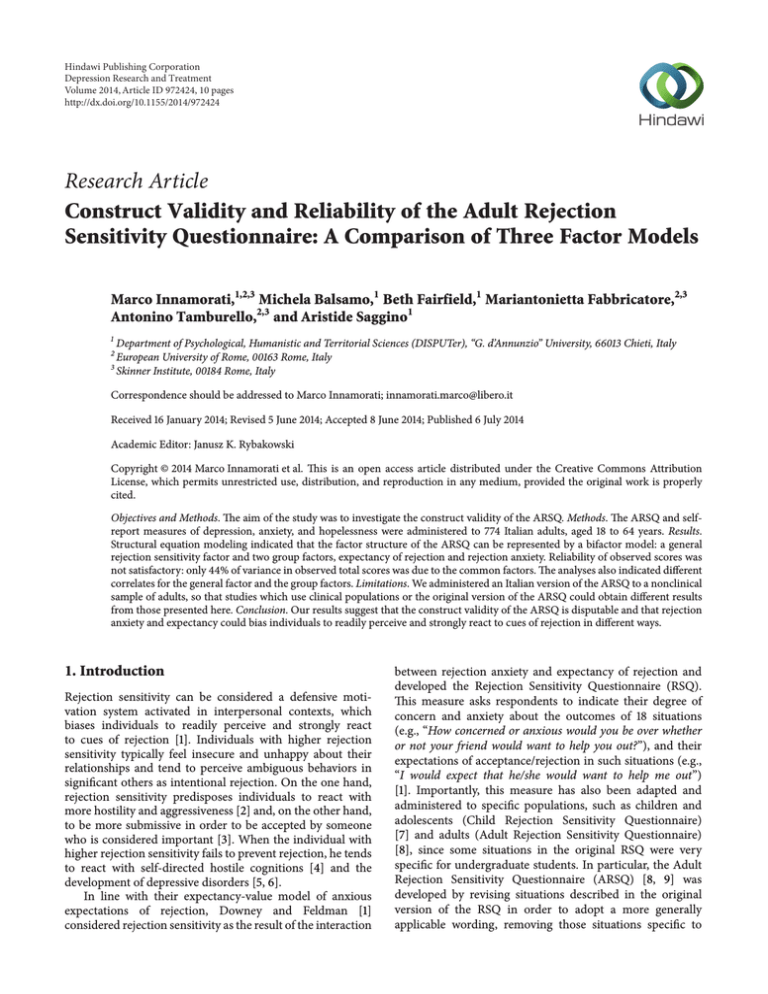
Hindawi Publishing Corporation
Depression Research and Treatment
Volume 2014, Article ID 972424, 10 pages
http://dx.doi.org/10.1155/2014/972424
Research Article
Construct Validity and Reliability of the Adult Rejection
Sensitivity Questionnaire: A Comparison of Three Factor Models
Marco Innamorati,1,2,3 Michela Balsamo,1 Beth Fairfield,1 Mariantonietta Fabbricatore,2,3
Antonino Tamburello,2,3 and Aristide Saggino1
1
Department of Psychological, Humanistic and Territorial Sciences (DISPUTer), “G. d’Annunzio” University, 66013 Chieti, Italy
European University of Rome, 00163 Rome, Italy
3
Skinner Institute, 00184 Rome, Italy
2
Correspondence should be addressed to Marco Innamorati; innamorati.marco@libero.it
Received 16 January 2014; Revised 5 June 2014; Accepted 8 June 2014; Published 6 July 2014
Academic Editor: Janusz K. Rybakowski
Copyright © 2014 Marco Innamorati et al. This is an open access article distributed under the Creative Commons Attribution
License, which permits unrestricted use, distribution, and reproduction in any medium, provided the original work is properly
cited.
Objectives and Methods. The aim of the study was to investigate the construct validity of the ARSQ. Methods. The ARSQ and selfreport measures of depression, anxiety, and hopelessness were administered to 774 Italian adults, aged 18 to 64 years. Results.
Structural equation modeling indicated that the factor structure of the ARSQ can be represented by a bifactor model: a general
rejection sensitivity factor and two group factors, expectancy of rejection and rejection anxiety. Reliability of observed scores was
not satisfactory: only 44% of variance in observed total scores was due to the common factors. The analyses also indicated different
correlates for the general factor and the group factors. Limitations. We administered an Italian version of the ARSQ to a nonclinical
sample of adults, so that studies which use clinical populations or the original version of the ARSQ could obtain different results
from those presented here. Conclusion. Our results suggest that the construct validity of the ARSQ is disputable and that rejection
anxiety and expectancy could bias individuals to readily perceive and strongly react to cues of rejection in different ways.
1. Introduction
Rejection sensitivity can be considered a defensive motivation system activated in interpersonal contexts, which
biases individuals to readily perceive and strongly react
to cues of rejection [1]. Individuals with higher rejection
sensitivity typically feel insecure and unhappy about their
relationships and tend to perceive ambiguous behaviors in
significant others as intentional rejection. On the one hand,
rejection sensitivity predisposes individuals to react with
more hostility and aggressiveness [2] and, on the other hand,
to be more submissive in order to be accepted by someone
who is considered important [3]. When the individual with
higher rejection sensitivity fails to prevent rejection, he tends
to react with self-directed hostile cognitions [4] and the
development of depressive disorders [5, 6].
In line with their expectancy-value model of anxious
expectations of rejection, Downey and Feldman [1]
considered rejection sensitivity as the result of the interaction
between rejection anxiety and expectancy of rejection and
developed the Rejection Sensitivity Questionnaire (RSQ).
This measure asks respondents to indicate their degree of
concern and anxiety about the outcomes of 18 situations
(e.g., “How concerned or anxious would you be over whether
or not your friend would want to help you out?”), and their
expectations of acceptance/rejection in such situations (e.g.,
“I would expect that he/she would want to help me out”)
[1]. Importantly, this measure has also been adapted and
administered to specific populations, such as children and
adolescents (Child Rejection Sensitivity Questionnaire)
[7] and adults (Adult Rejection Sensitivity Questionnaire)
[8], since some situations in the original RSQ were very
specific for undergraduate students. In particular, the Adult
Rejection Sensitivity Questionnaire (ARSQ) [8, 9] was
developed by revising situations described in the original
version of the RSQ in order to adopt a more generally
applicable wording, removing those situations specific to
2
college life, and generating additional items about potential
rejection situations in typical adult lives.
To date, the ARSQ has been used only in few studies
with US samples [10, 11], and little information is available
on its psychometric properties. Downey et al. [9] reported
that the ARSQ correlated strongly with the original RSQ (𝑟 =
0.87) and had sufficient reliability (Cronbach alpha = 0.74).
Berenson et al. [8] administered the ARSQ to 685 adults in an
Internet survey and reported that, controlling for education,
the ARSQ showed moderate associations with measures of
neuroticism (𝑟 = 0.32), social avoidance/distress (𝑟 = 0.34),
self-esteem (𝑟 = 0.46), attachment anxiety (𝑟 = 0.48) and
avoidance (𝑟 = 0.33), interpersonal sensitivity (𝑟 = 0.45),
and depression (𝑟 = 0.37). The authors also reported that the
validity of the ARSQ was supported by its ability to reflect
the individual differences in rejection sensitivity associated
with serious forms of psychopathology in which rejection
concerns are prominent [11].
However, to date, the psychometric properties of the
ARSQ have not been fully investigated; for example, no
studies assessed its dimensionality. The authors referred to
the original 18-situation RSQ for the procedure of scoring
and implicitly accepted the results of studies investigating
the dimensionality of the RSQ as valid. However, to the
best of our knowledge, the dimensionality of the RSQ is
essentially based on the original study by Downey and
Feldman [1], who first calculated RSQ composite scores by
weighting the expected likelihood of rejection and the degree
of concern over its occurrence and then submitting these
composite scores to a principal component analysis. The
authors interpreted their results as support in favor of the
unidimensionality of the questionnaire, although the analyses
performed on the whole sample and separately for each sex
resulted in some factor loadings in the range 0.30–0.40,
suggesting a less than strong homogeneity of content [1].
Thus, the evidence supporting the use of the ARSQ in the
adult population is scarce, and information on the validity
of this questionnaire is still limited. Thus, the major aim of
the present research was to investigate construct validity of
the ARSQ. First, we investigated the dimensionality of the
ARSQ, comparing the original one-factor model (Figure 1)
investigated by Downey and Feldman [1] in the original
study on the RSQ with two alternative models (a 2nd-order
factor model (Figure 2) and a bifactor model (Figure 3)).
Furthermore, the one-factor model assumes that rejection
expectancy and rejection concern contribute equally to the
final rejection sensitivity score. The 2nd-order factor model
(compared to the one-factor model) has the advantage that
it tests the assumption that rejection sensitivity scores could
be derived from weighting, for each situation, the expected
likelihood of rejection and the degree of concern over its
occurrence. Similarly, compared with the one-factor model,
the bifactor model provides other advantages, permitting to
address some questions still unexplored. (1) Is the ARSQ
unidimensional or multidimensional? (2) To what degree
does total scale score reflect reliable variation on a single
construct? (3) Could rejection anxiety and expectancy be
considered as two independent dimensions?
Depression Research and Treatment
RS1
RS2
RS3
RS4
Gf
RS5
RS6
RS7
RS8
RS9
Figure 1: One-factor model.
The bifactor model supposes the existence of a general
factor explaining the covariance shared by all items and
two specific factors explaining the covariance of single
groups of items (groups of items assessing either anxiety
for potential rejection or expectancy of rejection in each
situation). Within the inspection of factor loadings of the
bifactor model, if all items load strongly on the general factor
and moderately on the group factors, evidence supporting
a “quasi-unidimensionality” of the ARSQ is supported. On
the contrary, if factor loadings for the group factors are
strong, evidence for the multidimensionality of the ARSQ is
supported.
Second, for the best fitting model we used McDonald’s
omega coefficients [12] to estimate reliability of the ARSQ
and the proportion of the ARSQ score variance attributable
to each common factor. Last, we investigated convergent
validity with well-established measures of psychopathology
(anxiety, depression, and hopelessness). Consistent with
results reported by Berenson et al. [8], we expected the
ARSQ to be positively and significantly associated with these
convergent measures. Discriminant validity of the ARSQ
and its subscales was examined comparing the pairs of
correlation coefficients through the approach recommended
by Meng et al. [13].
2. Materials and Methods
2.1. Participants and Procedure. We recruited 774 Italian
adults (334 men and 430 women; mean age: 31.83 ± 14.45
years; age range: 18–64 years), between January 2011 and
May 2011 in Central and Southern Italy. Sociodemographic
Depression Research and Treatment
3
1A
RS1
1B
2A
RS2
2B
3A
RS3
3B
4A
RS4
Gf
4B
5A
RS5
5B
6A
RS6
6B
7A
RS7
8B
9A
RS9
9B
Figure 2: 2nd-order factor model.
1A
1B
2A
2B
3A
3B
Gf
4A
4B
5A
5B
RE
Age—M (SD)
Young adults—counts (%)
Adults—counts (%)
Women—counts (%)
Job—counts (%)
Students
Employed
Unemployed/retired
Marital status—counts (%)
Not married
Married
Divorced
Widowed
31.83 (14.45)
493 (64.5)
271 (35.5)
430 (56.3)
379 (49.6)
304 (39.8)
70 (9.2)
485 (63.5)
243 (31.8)
23 (3.0)
8 (1.0)
7B
8A
RS8
RA
Table 1: Sociodemographic characteristics of the sample (𝑁 = 774).
6A
6B
7A
7B
8A
8B
9A
9B
Figure 3: Bifactor model.
characteristics of the sample are reported in Table 1. Inclusion
criteria included age between 18 and 64 years and the ability
to read and write in Italian. Exclusion criteria included the
presence of any condition affecting the ability to complete
the assessment, including illiteracy and denial of informed
consent. The sample was recruited through attendants of
adult education classes and an advertisement posted for
established community groups. All participants voluntarily
took part in the study, gave informed consent, and completed
the assessment anonymously.
2.2. Measures. All participants were administered the ARSQ
and validated Italian versions of the Beck Depression
Inventory-II (BDI-II) [14], the Beck Hopelessness Scale
(BHS) [15], and the Beck Anxiety Inventory (BAI) [16].
The ARSQ is an 18-item inventory specifically devised
to measure rejection sensitivity in an adult population. The
ARSQ consists of nine hypothetical situations involving
interactions with partners, family, friends, and strangers, with
potential rejection (e.g., “You approach a close friend to talk
after doing or saying something that seriously upset him/her,”
“You ask your parents or another family member for a loan
to help you through a difficult financial time,” “You bring up
the issue of sexual protection with your significant other and
tell him/her how important you think it is”). Respondents
are asked to rate the degree to which they are concerned
or anxious over their reaction and the expectancy to be
rejected on a 6-point Likert-type scale (ranging from 1,
“very unconcerned,” to 6, “very concerned,” and from 1, “very
unlikely,” to 6, “very likely”). The Italian version of the ARSQ
was translated from the original English version by two
authors of the present study (MI, MB); the resulting Italian
version was then independently and blindly back translated
by a native English speaking researcher.
The BDI-II is a well-known self-report inventory composed of 21 items designed to assess the presence and
severity of depressive symptoms, according to DSM-IV [17]
criteria. Respondents endorse specific statements reflecting
their feelings over the last two weeks, including today. Each
statement is rated on a 4-point Likert-type scale ranging
from 0 to 3, based on the severity of depressive symptoms.
Importantly, extensive literature supports the psychometric
properties of the scale in clinical and nonclinical samples for
the Italian version of the scale as well [18–20].
The BHS is a 20-item scale that measures negative
attitudes about the future [15]. When responding to the
20 true-false items on the BHS, individuals either endorse
a pessimistic statement or deny an optimistic statement.
Research has consistently supported a positive significant
4
Depression Research and Treatment
relationship between BHS scores and measures of depression,
suicidal intent, and suicidal ideation [21–25]. Studies on the
Italian version of the BHS have been carried out successfully
[26–28] and have led to validation of the scale [29].
The BAI is a 21-item self-report scale developed for
measuring the severity of anxiety symptoms (e.g., “wobbliness
in legs” and “fear of losing control”). Respondents have to
rate how much they have been bothered by each symptom
over the past week on a 4-point Likert-type scale, ranging
from 0 (not at all) to 3 (severely). Past research has reported
good psychometric properties for the original [30–35] and
the Italian version of the BAI as well [36, 37].
2.3. Statistical Analysis. In line with our overall aim of
determining the dimensionality of the ARSQ, we compared
three different models.
(1) A one-factor model (Figure 1) that is the model
suggested from the study of Downey and Feldman
[1] and supported by the authors of the ARSQ [8,
9]: in this model nine manifest variables, derived
by weighing the response of the respondent on the
expected likelihood of rejection for the response of
the respondent on the degree of concern over its
occurrence for each situation, load on a single latent
factor.
(2) A 2nd-order factor model (Figure 2): despite the fact
that this model has never been investigated previously, it may fully represent the model of rejection
sensitivity supported by Downey and Feldman [1]:
in the left part of the diagram, manifest variables,
obtained directly from the respondent’s response to
each item, load on 9 first-order rejection sensitivity
factors, and in the right part of the diagram these
factors load on a second-order latent common factor.
We investigated this model, because the one-factor
model and the other models included in our analyses
have different manifest variables, and it is difficult to
compare the fit of the competing models because of
the different set of manifest variables used.
(3) A bifactor model (Figure 3) [38]: in this model, each
item loads on a general factor and a group factor [39].
The general factor explains the covariance shared by
all items. The group factors account for the covariance
independent of the general factor. The general factor
and group factors are uncorrelated and account for
the covariance simultaneously and independently for
each item.
Due to the ordinal nature of the ARSQ items, we performed analyses with a Robust Diagonally Weighted Least
Squares estimator (DWLSE) on a polychoric correlational
matrix. All analyses were performed using the statistical
package Lisrel 8.8 [40]. We evaluated the fit of the model by
means of the following indeces.
(a) The Root Mean Square Error of Approximation
(RMSEA): Browne and Cudeck [41] indicated values
between 0.05 and 0.08 as indicators of acceptable fit,
and values lower than 0.05 as indicators of good fit of
the model tested. Hu and Bentler [42] recommended
values lower than 0.06.
(b) The Incremental Comparative Fit Index (CFI): values
higher than 0.95/0.96 indicate a good model fit [42].
(c) The Satorra-Bentler Scaled Chi-Square (𝜒2 ): nonsignificant values indicate good model fit. Nevertheless, this index is dependent on sample size; thus, it
always tends to be significant in large samples [43].
(d) The Standardized Root Mean Square Residual
(SRMR): this is an index of absolute fit. It indicates a
perfect fit of the model when values are close to zero.
Hu and Bentler [42] suggested values lower than 0.08
as index of satisfactory model fit.
Cronbach alpha [44], mean interitems correlation, and
corrected item-total correlations indices for the models that
satisfactorily fit data were reported. Furthermore, we handcalculated McDonald’s omega, omega H, and omega S indices
[45], according to the procedures suggested in Reise et al.
[46]. We reported the omega index since the Cronbach
alpha is considered a poor index of unidimensionality by
some authors [47], when assumptions of the essentially tauequivalent measurement model are not met (each item measures the same latent variable, on the same scale, with possibly
different amounts of error and different degrees of precision)
[48, 49]. On the contrary, McDonald’s omega is based on
the less restrictive congeneric model, which differs from
other models because it assumes that each item measures the
same latent variable with possibly different scales [48, 50].
Only when the assumptions of the essentially tau-equivalent
measurement model are met, omega and alpha values are
equals. Omega (the proportion of total score variance that
can be attributed to all factors, group and general factors),
omega H (the proportion of total score variance attributable
to the general factor), and omega S (the proportion of total
score variance that can be attributed to all group factors, after
controlling for the general factor) were reported as estimates
of the percentage of variance in observed scores due to
variance on the single general factor (i.e., rejection sensitivity)
and group factors (i.e., rejection anxiety and expectancy).
Finally, in order to explore the convergent validity of
the ARSQ with measures of psychopathology, we measured
the correlations of previously extracted factors with the
BDI-II, the BHS, and the BAI total scores. We used the
approach recommended by Meng et al. [13] to examine
discriminant validity of the ARSQ and its subscales. This
procedure involves performing a Fisher 𝑍 transformation on
the correlation coefficients so that they can be compared via
a 𝑡-test.
3. Results
3.1. Models Fit and Assessment. Fit statistics for the alternative
SEM models are reported in Table 2. The analysis indicated
that neither the original one-factor model nor the 2nd-order
factor model fitted the data, while the bifactor model had
adequate fit to the data (RMSEA = 0.077; 90% CI: 0.071/0.083;
Depression Research and Treatment
5
Table 2: Fit statistics for the concurrent models (estimator: Robust Diagonally Weighted Least Squares).
Satorra-Bentler
Scaled
Chi-Square
One-factor model [8, 9]
218.72∗
2nd-order factor model
1888.05∗
Bifactor model
∗
629.45
∗
Root Mean
Square Error of
Approximation
(RMSEA)
(90% CI)
0.098
(0.086/0.11)
0.14 (0.13/0.14)
0.077
(0.071/0.083)
Akaike
Information
Criterion (AIC)
Comparative Fit
Index (CFI)
Standardized
Root Mean
Square Residual
(SRMSR)
Degree of
freedom
254.72
0.89
0.060
27
1976.05
0.81
0.14
127
737.45
0.95
0.067
117
Significant for P < 0.001.
SRMSR = 0.066), supporting the presence of a general factor
(Rejection Sensitivity—ARSQ-RS) and two group factors
(Rejection Anxiety—RA, which includes the 9 items assessing anxiety for rejection, and Rejection expectancy—RE,
which includes the 9 items assessing expectancy of rejection).
When comparing factor loadings of the group factors
and those of the general factor, RE loadings were all greater
than the corresponding loadings on the general factor, while
only 4 of 9 RA loadings were greater than the corresponding
loadings on the general factor (see Table 3). Furthermore,
some residuals were large enough (>2.58) [51] to suppose
that the bifactor model might not satisfactorily estimate the
relationships between some pairs of variables.
3.2. Psychometric Properties of the Bifactor Model. Reliabilities and descriptive statistics for all measures administered
are reported in Table 4. Although internal consistency for
the general and the group factors was satisfactory, reliability
as measured with McDonald’s omega was not: only 44% of
variance in observed total scores was due to the common
factors (McDonald’s omega = 0.44), and only 28% was due
to the general factor (McDonald’s omega H = 0.28). Sixty-five
percent of the reliable variance in ARSQ scores was due to the
general factor and 35% to RA and RE.
For part A (composed of the 9 items loading on RA)
of the scale, 59% of variance in observed scores was due to
the common factors (McDonald’s omega = 0.59), and only
18% was due to RA (McDonald’s omega S = 0.18). That
means that only 30% of the reliable variance in observed
scores was due to RA independently of the general factor. For
part B (composed of the 9 items loading on RE) of the scale,
45% of variance in observed scores was due to the common
factors (McDonald’s omega = 0.45), and 34% was due to RE
(McDonald’s omega S = 0.34), so that 74% of the reliable
variance in observed scores was due to RE independently
of the general factor. The general factor and both the group
factors correlated significantly and positively with convergent
measures of depression, anxiety, and hopelessness, so that
individuals with higher rejection sensitivity reported more
depressive and anxiety symptoms and were more hopeless
(Table 5). The correlations of the general factor with the BDI
and the BAI were comparable to those of RA (𝑍 = 0.54;
𝑃 = 0.30 for the BDI; 𝑍 = 0.00; 𝑃 = 0.50 for the BAI),
except for the correlation with the BHS (𝑍 = 2.62; 𝑃 < 0.01),
and were greater than those of RE (𝑍 = 7.46; 𝑃 < 0.001
for the BDI; 𝑍 = 5.05; 𝑃 < 0.001 for the BAI; 𝑍 = 3.48;
𝑃 < 0.001 for the BHS). The correlations of RA with measures
of psychopathology were greater than those of RE (𝑍 = 4.18;
𝑃 < 0.001 for the BDI; 𝑍 = 3.00; 𝑃 < 0.001 for the BAI)
with the exclusion of the correlation with the BHS (𝑍 = 0.82;
𝑃 = 0.21).
4. Discussion
Our results suggest that the construct validity of the ARSQ is
disputable. The unidimensional model proposed by Downey
and Feldman [1] and supported by the authors of the ARSQ,
as well as the alternative 2nd-order factor model, did not fit
the data. Factor structure of the ARSQ may be represented by
a bifactor model with a general rejection sensitivity factor and
two group factors, rejection expectancy and rejection anxiety.
Furthermore, the underlying hypothesis of the bifactor model
according to which all the items will load strongly on the
general factor and moderately on the group factors, so that
the structure of the instrument could be considered mostly
unidimensional, was not supported by these results. The
pattern of factor loadings indicated that items, especially
those assessing expectancy of rejection, loaded more strongly
on the specific factors than on the general factor.
One other issue arising from the present study concerns
the reliability of the ARSQ. Although internal consistency
of group factors and the general factor was sufficient as
indicated by alpha coefficients ranging between 0.78 and
0.82, omega coefficients showed low reliability of the scores
of the ARSQ. This suggests that the assumptions of the
essentially tau-equivalent measurement model were not met
and indicates that the ARSQ total scores were not able
to capture well the latent common variable they intend
to measure. Furthermore, omega S coefficients seemed to
suggest that rejection expectancy is a separate dimension
of rejections sensitivity, and its specific roles in measuring
rejection sensitivity should be more properly investigated.
Our pattern of correlations with convergent measures of
psychopathology is consistent with the results reported by
Berenson et al. [8], who indicated that ARSQ scores were
moderately associated with neuroticism, social avoidance
and distress, attachment anxiety and avoidance, interpersonal sensitivity, and depression, and is also consistent with
6
Depression Research and Treatment
Table 3: Standardized factor loadings (measurement errors) for the bifactor model.
Items
Item 1—you ask your parents or another family member for
a loan to help you through a difficult financial time (Chiedi
ai tuoi genitori (o a un altro familiare) un prestito per
superare una fase economica difficile).
(a) How concerned or anxious would you be over whether or
not your family would want to help you (Quanto ti sentiresti
in ansia o preoccupato/a per il fatto che tuoi familiari
vogliano o non vogliano aiutarti)?
(b) I would expect that they would agree to help as much as
they can (Mi aspetto che loro vogliano aiutarmi il pi`u
possibile).
Item 2—you approach a close friend to talk after doing or
saying something that seriously upset him/her (Ti avvicini
per parlare a un tuo amico intimo (o amica intima) dopo che
hai fatto o detto qualcosa che l’ha veramente sconvolto/a).
(a) How concerned or anxious would you be over whether or
not your friend would want to talk with you (Quanto ti
sentiresti in ansia o preoccupato/a per il fatto che lui/lei ti
voglia o non ti voglia parlare)?
(b) I would expect that he/she would want to talk with me to
try to work things out (Mi aspetto che lui/lei voglia parlarmi
per risolvere le cose).
Item 3—you bring up the issue of sexual protection with
your significant other and tell him/her how important you
think it is (Inizi a dire al tuo partner quanto e` importante per
te usare misure di protezione durante il rapporto sessuale).
(a) How concerned or anxious would you be over his/her
reaction (Quanto ti sentiresti in ansia o preoccupato/a per la
sua reazione)?
(b) I would expect that he/she would be willing to discuss our
possible options without getting defensive (Mi aspetto che
lui/lei voglia discutere le possibili alternative senza mettersi
sulla difensiva).
Item 4—you ask your supervisor for help with a problem
you have been having at work (Chiedi al tuo supervisore un
aiuto per risolvere un problema che stai avendo nel tuo
lavoro).
(a) How concerned or anxious would you be over whether or
not the person would want to help you (Quanto ti sentiresti in
ansia o preoccupato/a per il fatto che lui/lei voglia o non
voglia aiutarti)?
(b) I would expect that he/she would want to try to help me
out (Mi aspetto che lui/lei voglia provare ad aiutarmi).
Item 5—after a bitter argument, you call or approach your
significant other because you want to make up (Dopo una
aspra discussione, ti avvicini per parlare (o telefoni) al tuo
partner perch`e vuoi risolvere il problema che si e` creato tra di
voi).
(a) How concerned or anxious would you be over whether or
not your significant other would want to make up with you
(Quanto ti sentiresti in ansia o preoccupato/a per il fatto che
lui/lei voglia o non voglia risolvere il problema che si e`
creato)?
(b) I would expect that he/she would be at least as eager to
make up as I would be (Mi aspetto che lui/lei sia desideroso/a
quanto me di risolvere il problema che si e` creato tra di noi).
Rejection anxiety
Rejection expectancy
General additive factor
0.20
—
0.52
—
0.50
0.21
0.44
—
0.31
0.47
0.12
—
0.64
0.49
0.40
—
0.27
0.51
0.41
0.62
—
0.20
0.31
0.49
0.62
0.30
Depression Research and Treatment
7
Table 3: Continued.
Items
Item 6—you ask your parents or other family members to
come to an occasion important to you (Chiedi ai tuoi
genitori (o a un altro familiare) di essere presenti per una
occasione importante per te).
(a) How concerned or anxious would you be over whether or
not they would want to come (Quanto ti sentiresti in ansia o
preoccupato per il fatto che loro vogliano o non vogliano
venire)?
(b) I would expect that they would want to come (Mi aspetto
che loro vogliano essere presenti).
Item 7—at a party, you notice someone on the other side of
the room that you’d like to get to know, and you approach
him or her to try to start a conversation (A una festa noti
una persona dall’altra parte della stanza che vorresti
conoscere e l’avvicini per provare ad iniziare una
conversazione).
(a) How concerned or anxious would you be over whether or
not the person would want to talk with you (Quanto ti
sentiresti in ansia o preoccupato/a per il fatto che questa
persona voglia o non voglia parlare con te)?
(b) I would expect that he/she would want to talk with me
(Mi aspetto che lui/lei voglia parlare con me).
Item 8—lately you’ve been noticing some distance between
yourself and your significant other, and you ask him/her if
there is something wrong (Ultimamente hai notato che si e`
creata una certa distanza tra te e il tuo partner e gli/le chiedi
se c’`e qualcosa che non va).
(a) How concerned or anxious would you be over whether or
not he/she still loves you and wants to be with you (Quanto ti
sentiresti in ansia o preoccupato/a per il fatto che lui/lei ti ami
ancora o no e voglia o non voglia stare con te?)?
(b) I would expect that he/she will show sincere love and
commitment to our relationship no matter what else may be
going on (Mi aspetto che lui/lei mi mostri un amore sincero e
desideri continuare la nostra relazione nonostante i problemi
che possano esserci).
Item 9—you call a friend when there is something on your
mind that you feel you really need to talk about (Telefoni a
un tuo amico/a perch`e hai qualcosa di cui hai veramente
bisogno di parlare).
(a) How concerned or anxious would you be over whether or
not your friend would want to listen (Quanto ti sentiresti in
ansia o preoccupato/a per il fatto che lui/lei voglia o non
voglia starti ad ascoltare)?
(b) I would expect that he/she would listen and support me
(Mi aspetto che lui/lei voglia starmi a sentire e darmi
supporto).
Rejection anxiety
the more vast literature on rejection sensitivity [6, 9, 11, 52–
57]. However, these analyses also indicated different correlates of the general factor and the group factors, especially for
rejection expectancy when compared with the general factor
or rejection anxiety. On the contrary, rejection anxiety had
different correlates than those of the general factor only for
hopelessness. These results are not surprising if we consider
that only 30% of the reliable variance in rejection anxiety
observed scores was independent of the general factor.
Rejection expectancy
0.09
—
0.77
0.60
0.48
—
0.33
0.39
0.38
0.56
0.09
—
0.37
0.42
0.68
—
General additive factor
0.25
0.75
0.56
0.39
Our study has limitations and strengths. Given that we
used an Italian version of the ARSQ, results with the original
version of the scale could be different. Furthermore, we only
used self-reported measures which could be biased by social
desirability [58, 59]. Nonetheless, an asset of the study is its
breadth of sample. Additionally, as far as we know, this is the
first study to investigate the dimensionality of the ARSQ. In
line with the expectancy-value model of anxious expectations
of rejection, Downey and Feldman [1] and the authors of
8
Depression Research and Treatment
Table 4: Descriptive statistics (𝑁 = 774).
ARSQ general factor
Rejection anxiety
Rejection expectancy
BDI-II
BAI
BHS
M (SD)
2.69 (0.74)
3.03 (1.02)
2.36 (0.82)
9.30 (8.20)
34.38 (10.89)
4.89 (4.08)
Cronbach alpha
0.82
0.82
0.78
0.89
0.92
0.85
Interitem mean correlation
0.20
0.34
0.28
0.29
0.35
0.22
McDonald’s omega H
0.28
0.05
0.10
—
—
—
McDonald’s omega S
—
0.18
0.34
—
—
—
ARSQ: Adult Rejection Sensitivity Questionnaire; BDI-II: Beck Depression Inventory-II; BAI: Beck Anxiety Inventory; BHS: Beck Hopelessness Scale.
Table 5: Correlations between measures (𝑁 = 772).
1
1
2
3
4
5
6
ARSQ general factor
Rejection anxiety
Rejection expectancy
BDI-II
BAI
BHS
0.84∗∗
0.75∗∗
0.41∗∗
0.31∗∗
0.38∗∗
2
3
4
5
expectancy of rejection in the measurement of rejection
sensitivity.
Conflict of Interests
∗∗
0.27
0.40∗∗ 0.23∗∗
0.31∗∗ 0.16∗∗ 0.60∗∗
0.32∗∗ 0.28∗∗ 0.50∗∗ 0.29∗∗
∗∗
Correlation is significant at the 0.01 level (2-tailed).
ARSQ: Adult Rejection Sensitivity Questionnaire; BDI-II: Beck Depression
Inventory-II; BAI: Beck Anxiety Inventory; BHS: Beck Hopelessness Scale.
the ARSQ [8, 9] always investigated the dimensionality
of their measures by using “composite scores,” derived by
weighting scores on items measuring the expected likelihood
of rejection by scores on items measuring the degree of
concern over its occurrence for each situation as measured
variables. In our study, we compared the single-factor model
with “composite scores” as measured variables with two other
models that used items assessing the expected likelihood of
rejection and items measuring the degree of concern over its
occurrence as measured variables. Accordingly, we calculated
rejections sensitivity scores by summing up all the items
of the ARSQ, while in their research the authors of the
ARSQ calculated rejections sensitivity scores summing up
“composite scores.” A further limitation is that these differing
procedures may produce scores with differing properties,
and, therefore, future studies will have to compare the pros
and cons of these two models of scoring. Last, our sample was
extracted from a nonclinical population; thus, the assessment
of the factor structure of the ARSQ may produce different
results in clinical populations.
In conclusion, our findings raise questions about the
construct validity of the ARSQ. In our nonclinical sample, the
ARSQ appears not able to capture well the general dimension
of rejection sensitivity. Furthermore, rejection anxiety and
expectancy could bias individuals to readily perceive and
strongly react to cues of rejection in different ways. Thus,
caution should be used in interpreting the results from
those studies which used the ARSQ, and in interpreting the
expectancy-value model of anxious expectations of rejection.
However, future research is needed and should focus on
the study of the psychometric characteristics of the original
version of the ARSQ in clinical and nonclinical populations.
Furthermore, it is pivotal to further investigate the role of
The authors declare that they have no conflict of interests
regarding this research.
Authors’ Contribution
All authors have made substantial contributions to conception and design or acquisition of data or analysis and interpretation of data, have been involved in drafting the paper
or revising it critically for important intellectual content, and
have given final approval of the version to be published.
References
[1] G. Downey and S. I. Feldman, “Implications of rejection
sensitivity for intimate relationships,” Journal of Personality and
Social Psychology, vol. 70, no. 6, pp. 1327–1343, 1996.
[2] R. Romero-Canyas, G. Downey, K. Berenson, O. Ayduk, and N.
J. Kang, “Rejection sensitivity and the rejection-hostility link in
romantic relationships,” Journal of Personality, vol. 78, no. 1, pp.
119–148, 2010.
[3] R. Romero-Canyas, G. Downey, K. S. Reddy, S. Rodriguez, T.
J. Cavanaugh, and R. Pelayo, “Paying to belong: when does
rejection trigger ingratiation?” Journal of Personality and Social
Psychology, vol. 99, no. 5, pp. 802–823, 2010.
[4] J. G. Breines and O. Ayduk, “Rejection sensitivity and vulnerability to self-directed hostile cognitions following rejection,”
Journal of Personality, 2013.
[5] O. Ayduk, G. Downey, and M. Kim, “Rejection sensitivity
and depressive symptoms in women,” Personality and Social
Psychology Bulletin, vol. 27, no. 7, pp. 868–877, 2001.
[6] J. M. Chango, K. B. McElhaney, J. P. Allen, M. M. Schad, and E.
Marston, “Relational stressors and depressive symptoms in late
adolescence: rejection sensitivity as a vulnerability,” Journal of
Abnormal Child Psychology, vol. 40, no. 3, pp. 369–379, 2012.
[7] G. Downey, A. Lebolt, C. Rinc´on, and A. L. Freitas, “Rejection
sensitivity and children’s interpersonal difficulties,” Child Development, vol. 69, no. 4, pp. 1074–1091, 1998.
¨ Ayduk et al., “Rejection sensitiv[8] K. R. Berenson, A. Gyurak, O.
ity and disruption of attention by social threat cues,” Journal of
Research in Personality, vol. 43, no. 6, pp. 1064–1072, 2009.
[9] G. Downey, K. R. Berenson, and J. Kang, Correlates of the Adult
Rejection Sensitivity Questionnaire, Columbia University, 2006.
Depression Research and Treatment
[10] K. A. Pearson, E. R. Watkins, and E. G. Mullan, “Rejection sensitivity prospectively predicts increased rumination,” Behaviour
Research and Therapy, vol. 49, no. 10, pp. 597–605, 2011.
[11] K. R. Berenson, G. Downey, E. Rafaeli, K. G. Coifman, and N.
Leventhal Paquin, “The rejection-rage contingency in borderline personality disorder,” Journal of Abnormal Psychology, vol.
120, no. 3, pp. 681–690, 2011.
[12] R. E. Zinbarg, W. Revelle, I. Yovel et al., “Cronbach’s alpha,
Revelle’s beta, and McDonald’s omega h: their relations with
each other and two alternative conceptualizations of reliability,”
Psychometrika, vol. 70, no. 1, pp. 123–133, 2005.
[13] X. Meng, R. Rosenthal, and D. B. Rubin, “Comparing correlated
correlation coefficients,” Psychological Bulletin, vol. 111, no. 1, pp.
172–175, 1992.
[14] A. T. Beck, R. A. Steer, and G. K. Brown, Manual for the Depression Inventory-II, Psychological Corporation, San Antonio, Tex,
USA, 1996.
[15] A. T. Beck, A. Weissman, D. Lester, and L. Trexler, “The
measurement of pessimism: the hopelessness scale,” Journal of
Consulting and Clinical Psychology, vol. 42, no. 6, pp. 861–865,
1974.
[16] A. T. Beck, N. Epstein, G. Brown, and R. A. Steer, “An inventory for measuring clinical anxiety: psychometric properties,”
Journal of Consulting and Clinical Psychology, vol. 56, no. 6, pp.
893–897, 1988.
[17] American Psychiatric Association, Diagnostic and Statistical
Manual of Mental Disorders, American Psychiatric Association,
Washington, DC, USA, 4th edition, 2000.
[18] M. Balsamo and A. Saggino, “Test per l’assessment della
depressione nel contesto italiano: un’analisi critica,” Psicoterapia
Cognitiva e Comportamentale, vol. 13, pp. 167–199, 2007.
[19] A. Montano and G. B. Flebus, “Presentazione del Beck Depression Inventory-seconda edizione (BDI-II): conferma della
struttura bifattoriale in un campione di popolazione italiana,”
Psicoterapia Cognitiva e Comportamentale, vol. 12, pp. 67–82,
2006.
[20] M. Ghisi, G. B. Flebus, A. Montano et al., Beck Depression Inventory, Adattamento Italiano: Manuale, Organizzazioni Speciali,
Florence, Italy, 2nd edition, 2006.
[21] A. T. Beck, G. Brown, R. J. Berchick, B. L. Stewart, and R. A.
Steer, “Relationship between hopelessness and ultimate suicide:
a replication with psychiatric outpatients,” American Journal of
Psychiatry, vol. 147, no. 2, pp. 190–195, 1990.
[22] E. David Klonsky, R. Kotov, S. Bakst, J. Rabinowitz, and E.
J. Bromet, “Hopelessness as a predictor of attempted suicide
among first admission patients with psychosis: a10-year cohort
study,” Suicide and Life-Threatening Behavior, vol. 42, no. 1, pp.
1–10, 2012.
[23] M. Bouvard, S. Charles, J. Guerin, G. Aimard, and J. Cottraux,
“Study of the hoplessness scale: validation and factorial analysis,” Encephale, vol. 18, no. 3, pp. 237–240, 1992.
[24] M. Innamorati, M. Pompili, X. Gonda et al., “Psychometric
properties of the Gotland Scale for Depression in Italian
psychiatric inpatients and its utility in the prediction of suicide
risk,” Journal of Affective Disorders, vol. 132, no. 1-2, pp. 99–103,
2011.
[25] M. Innamorati, M. Pompili, G. Serafini et al., “Psychometric
properties of the suicidal history self-rating screening scale,”
Archives of Suicide Research, vol. 15, no. 1, pp. 87–92, 2011.
[26] M. Balsamo, C. Imperatori, M. R. Sergi et al., “Cognitive
vulnerabilities and depression in young adults: an ROC curves
9
[27]
[28]
[29]
[30]
[31]
[32]
[33]
[34]
[35]
[36]
[37]
[38]
[39]
[40]
[41]
[42]
analysis,” Depression Research and Treatment, vol. 2013, Article
ID 407602, 8 pages, 2013.
M. Pompili, R. Tatarelli, J. R. Rogers, and D. Lester, “The
hopelessness scale: a factor analysis,” Psychological Reports, vol.
100, no. 2, pp. 375–378, 2007.
M. Innamorati, D. Lester, M. Balsamo et al., “Factor validity of
the Beck Hopelessness Scale in Italian medical patients,” Journal
of Psychopathology and Behavioral Assessment, vol. 36, no. 2, pp.
300–307, 2014.
M. Pompili, P. Iliceto, D. Lester et al., BHS Beck Hopelessness
Scale: Manuale, Giunti O.S. Organizzazioni Speciali, Firenze,
Italy, 2009.
A. Osman, J. Hoffman, F. X. Barrios, B. A. Kopper, J. L.
Breitenstein, and S. K. Hahn, “Factor structure, reliability, and
validity of the Beck Anxiety Inventory in adolescent psychiatric
inpatients,” Journal of Clinical Psychology, vol. 58, no. 4, pp. 443–
456, 2002.
T. Fydrich, D. Dowdall, and D. L. Chambless, “Reliability
and validity of the beck anxiety inventory,” Journal of Anxiety
Disorders, vol. 6, no. 1, pp. 55–61, 1992.
A. D. T. Muntingh, C. M. van der Feltz-Cornelis, H. W. J.
van Marwijk, P. Spinhoven, B. W. J. H. Penninx, and A. J. L.
M. van Balkom, “Is the beck anxiety inventory a good tool
to assess the severity of anxiety? A primary care study in the
Netherlands study of depression and anxiety (NESDA),” BMC
Family Practice, vol. 12, article 66, 2011.
I. Mag´an, J. Sanz, and M. P. Garc´ıa-Vera, “Psychometric properties of a Spanish version of the Beck anxiety inventory (BAI) in
general population,” The Spanish Journal of Psychology, vol. 11,
no. 2, pp. 626–640, 2008.
P. L. Hewitt and G. R. Norton, “The beck anxiety inventory: a
psychometric analysis,” Psychological Assessment, vol. 5, no. 4,
pp. 408–412, 1993.
R. J. De Ayala, D. J. Vonderharr-Carlson, and D. Kim, “Assessing
the reliability of the Beck anxiety inventory scores,” Educational
and Psychological Measurement, vol. 65, no. 5, pp. 742–756,
2005.
M. Balsamo, R. Romanelli, M. Innamorati, G. Ciccarese, L.
Carlucci, and A. Saggino, “The state-trait anxiety inventory:
shadows and lights on its construct validity,” Journal of Psychopathology and Behavioral Assessment, vol. 35, no. 4, pp. 475–
486, 2013.
D. Coradeschi, C. Sica, M. Ghisi et al., “Studi preliminari sulle
propriet`a psicometriche del Beck Anxiety Inventory,” Bollettino
di Psicologia Applicata, vol. 253, pp. 15–25, 2007.
K. J. Holzinger and F. Swineford, “The Bi-factor method,”
Psychometrika, vol. 2, no. 1, pp. 41–54, 1937.
N. Deng, C. Wells, and R. Hambleton, “A confirmatory factor
analytic study examining the dimensionality of educational
achievement tests,” in NERA Conference Proceedings, Rocky
Hill, Conn, USA, October 2008.
K. G. J¨oreskog and D. S¨orbom, LISREL for Windows [Computer
Software], Scientific Software International, Lincolnwood, Ill,
USA, 2006.
M. W. Browne and R. Cudek, “Alternative ways of assessing
model fit,” in Testing Structural Equation Models, J. S. Long, Ed.,
pp. 136–162, Sage, Newbury Park, Calif, USA, 1993.
L. Hu and P. M. Bentler, “Cutoff criteria for fit indexes in
covariance structure analysis: conventional criteria versus new
alternatives,” Structural Equation Modeling, vol. 6, no. 1, pp. 1–
55, 1999.
10
[43] P. M. Bentler and D. G. Bonett, “Significance tests and goodness
of fit in the analysis of covariance structures,” Psychological
Bulletin, vol. 88, no. 3, pp. 588–606, 1980.
[44] L. J. Cronbach, “Coefficient alpha and the internal structure of
tests,” Psychometrika, vol. 16, no. 3, pp. 297–334, 1951.
[45] R. P. McDonald, Test Theory: A Unified Treatment, Lawrence
Erlbaum Associates, Mahwah, NJ, USA, 1999.
[46] S. P. Reise, W. E. Bonifay, and M. G. Haviland, “Scoring and
modeling psychological measures in the presence of multidimensionality,” Journal of Personality Assessment, vol. 95, no. 2,
pp. 129–140, 2013.
[47] K. Sijtsma, “On the use, the misuse, and the very limited
usefulness of Cronbach's alpha,” Psychometrika, vol. 74, no. 1,
pp. 107–120, 2009.
[48] T. Raykov, “Estimation of composite reliability for congeneric
measures,” Applied Psychological Measurement, vol. 21, no. 2, pp.
173–184, 1997.
[49] M. B. Miller, “Coefficient alpha: a basic introduction from the
perspectives of classical test theory and structural equation
modeling,” Structural Equation Modeling, vol. 2, pp. 255–273,
1995.
[50] J. M. Graham, “Congeneric and (essentially) tau-equivalent
estimates of score reliability: what they are and how to use
them,” Educational and Psychological Measurement, vol. 66, no.
6, pp. 930–944, 2006.
[51] J. C. Anderson and D. W. Gerbing, “Structural equation modeling in practice: a review and recommended two-step approach,”
Psychological Bulletin, vol. 103, no. 3, pp. 411–423, 1988.
[52] G. Downey, S. Feldman, and O. Ayduk, “Rejection sensitivity
and male violence in romantic relationships,” Personal Relationships, vol. 7, no. 1, pp. 45–61, 2000.
¨ Ayduk, V. Zayas, G. Downey, A. B. Cole, Y. Shoda, and W.
[53] O.
Mischel, “Rejection sensitivity and executive control: joint predictors of borderline personality features,” Journal of Research
in Personality, vol. 42, no. 1, pp. 151–168, 2008.
[54] K. L. McDonald, J. C. Bowker, K. H. Rubin, B. Laursen,
and M. S. Duchene, “Interactions between rejection sensitivity
and supportive relationships in the prediction of adolescents’
internalizing difficulties,” Journal of Youth and Adolescence, vol.
39, no. 5, pp. 563–574, 2010.
[55] S. Feldman and G. Downey, “Rejection sensitivity as a mediator
of the impact of childhood exposure to family violence on adult
attachment behavior,” Development and Psychopathology, vol. 6,
pp. 231–47, 1994.
[56] E. G. Marston, A. Hare, and J. P. Allen, “Rejection sensitivity
in late adolescence: social and emotional sequelae,” Journal of
Research on Adolescence, vol. 20, no. 4, pp. 959–982, 2010.
[57] B. London, G. Downey, C. Bonica, and I. Paltin, “Social causes
and consequences of rejection sensitivity,” Journal of Research
on Adolescence, vol. 17, no. 3, pp. 481–506, 2007.
[58] E. E. Maccoby and N. A. Maccoby, “The interview: a tool of
social science,” in Handbook of Social Psychology, G. Lindzey,
Ed., pp. 449–87, Addison-Wesley, Cambridge, Mass, USA, 1954.
[59] H. J. Arnold and D. C. Feldman, “Social desirability response
bias in self-report choice situations,” Academy of Management
Journal, vol. 24, pp. 377–85, 1981.
Depression Research and Treatment
MEDIATORS
of
INFLAMMATION
The Scientific
World Journal
Hindawi Publishing Corporation
http://www.hindawi.com
Volume 2014
Gastroenterology
Research and Practice
Hindawi Publishing Corporation
http://www.hindawi.com
Volume 2014
Journal of
Hindawi Publishing Corporation
http://www.hindawi.com
Diabetes Research
Volume 2014
Hindawi Publishing Corporation
http://www.hindawi.com
Volume 2014
Hindawi Publishing Corporation
http://www.hindawi.com
Volume 2014
International Journal of
Journal of
Endocrinology
Immunology Research
Hindawi Publishing Corporation
http://www.hindawi.com
Disease Markers
Hindawi Publishing Corporation
http://www.hindawi.com
Volume 2014
Volume 2014
Submit your manuscripts at
http://www.hindawi.com
BioMed
Research International
PPAR Research
Hindawi Publishing Corporation
http://www.hindawi.com
Hindawi Publishing Corporation
http://www.hindawi.com
Volume 2014
Volume 2014
Journal of
Obesity
Journal of
Ophthalmology
Hindawi Publishing Corporation
http://www.hindawi.com
Volume 2014
Evidence-Based
Complementary and
Alternative Medicine
Stem Cells
International
Hindawi Publishing Corporation
http://www.hindawi.com
Volume 2014
Hindawi Publishing Corporation
http://www.hindawi.com
Volume 2014
Journal of
Oncology
Hindawi Publishing Corporation
http://www.hindawi.com
Volume 2014
Hindawi Publishing Corporation
http://www.hindawi.com
Volume 2014
Parkinson’s
Disease
Computational and
Mathematical Methods
in Medicine
Hindawi Publishing Corporation
http://www.hindawi.com
Volume 2014
AIDS
Behavioural
Neurology
Hindawi Publishing Corporation
http://www.hindawi.com
Research and Treatment
Volume 2014
Hindawi Publishing Corporation
http://www.hindawi.com
Volume 2014
Hindawi Publishing Corporation
http://www.hindawi.com
Volume 2014
Oxidative Medicine and
Cellular Longevity
Hindawi Publishing Corporation
http://www.hindawi.com
Volume 2014

